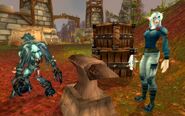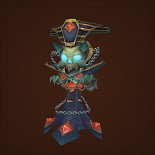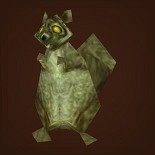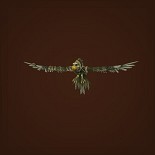|
Caranlos at a glance
| |
|
Pronunciation
|
ka'ranlɔs a'rannɛxtar
|
|
Demographic
|
Young adult female night elf
|
|
Work
|
Death knight, blacksmith, miner
|
|
Alignment
|
Lawful neutral/evil
|
|
Motivation
|
Torment
|
|
Disposition
|
Calm and phlegmatic
|
|
Comportment
|
Courteous
|
|
Family
|
Yarralomë (father/uncle/husband)
Isilyë (mother/aunt) |
|
Cognomina
|
Crusader; the Insane; the Kingslayer
|
Caranlos (formerly “Lómion”) was the one surviving child of the infamous “Cannibals of Darkshore”. Her identity as such was kept secret, but she later earned fame as a champion of the Silverwing Sentinels and the Argent Dawn before falling victim to uxoricide, undeath, and service in the Lich King’s army.
After the Ebon Blade’s release from the Lich King’s control, Caranlos entered into legend and song as a hero of the Alliance and model of chivalrous service, but her increasingly violent episodes and inexplicably shifting affiliations (eg, with the Steamwheedle cartel, then the Bloodsail Buccaneers, then Steamwheedle again) have put her on a watch list of allies that may soon need to be terminated.
Background
When the truth is ugly enough, ignorance always seems an attractive option.
And in Caranlos’ case, the kindest:
Her parents were Isilyë and Isilyë’s brother Yarralomë, two rising stars in Ashenvale’s defense who were eventually captured at Splintertree Post. Yarralomë had raped a blood elf named Ruinwen, and as punishment Ruinwen’s father turned Yarralomë and Isilyë (who had created a diversion so as to make the rape possible) into a breeding pair of druidical animals over a period of five years, collecting their offspring at the end of each year. But at the end of the final year, which the felonious siblings spent as moonkins, Ruinwen’s father was unable to distinguish the night elf moonkins from the real moonkins, and had to guess which ones to turn back into night elves. He guessed wrong.
The pair of moonkins who were now Isilyë and Yarralomë continued to mate even as they spent the next year starving, and when Caranlos and her twin brother were born, they crushed his head with a rock and ate him. Luckily for Caranlos, elves from Auberdine discovered them and rescued her before they could eat her as well.
Caranlos was then taken to Forest Song in Ashenvale, where she was called Lómion (she had no name before then) and trained to serve as a Sentinel. For the rest of her life, Lómion never knew anything about her parents beyond what the Sentinels had told her — which was that they were “Lómiël” and “Lómindur”, heroes captured and killed at Splintertree Post — and never gave them a second thought. The Sentinels and the Hand of Argus were the only family she knew, and all the family she needed, though as she grew older, her reputation as a fierce fighter against the Burning Legion and the Scourge also led her to long association with the Argent Dawn.
Years later, she met an older man who seemed uncannily well suited to her — they shared the same views on important topics, had many of the same tastes, the same humor — and soon after they were married at Light's Hope Chapel.
But then a mysterious package containing a journal by famed speech therapist Gustaf Tetzel and related documents arrived the morning after their wedding. Whatever was in them caused Lómion’s husband to go berserk: he slit Lómion’s throat, slung her body over a horse, and sent it across enemy lines to the Scourge. Then he slit his own throat and bled out where he fell.

Rough wedding night: Lómion’s corpse near Scourge-controlled Browman Mill in the Eastern Plaguelands
The package, as it happened, was sent by Ruinwen, the blood elf who had been raped by Caranlos’ father years ago. Ruinwen was profoundly unsatisfied by the punishment her own father had meted out to Yarralomë and his scheming sister Isilyë, and had been hunting for them herself ever since. For all her efforts, though, she was never able to get to Isilyë — but she did find Yarralomë, who, her investigations revealed, had risen through the ranks of the druidical Cenarion Circle and was now about to marry a young woman from the Argent Dawn — Lómion. Neither bride nor groom had any idea that they were in fact father and daughter (as well as uncle and niece); the journal and accompanying reports revealed all to Yarralomë, and, as Ruinwen had hoped, he took the news badly.
But the worst was yet to come: Lómion’s body was then taken in by the Scourge and turned into one of the new breed of death knights, reanimated killing machines in the thrall of the Lich King.

Lómion reborn in Acherus, the floating Scourge necropolis in the Scarlet Enclave and headquarters of the Lich King’s Knights of the Ebon Blade

In the service of the Scourge: Now a battle-tested death knight, Lómion helps destroy the last standing army of the Scarlet Crusade
After the doomed battle of Light’s Hope Chapel, when the death knights of the Ebon Blade were freed of the Lich King’s will, Lómion set about trying to recapture the life that was hers before her death — her position with the Silverwing Sentinels, the Argent Dawn (now Argent Crusade), and, most importantly, herself. But it became apparent to her over the years that her old self was gone for good, and that her new self was still every bit the bloodthirsty monster it was when she was in the service of the Lich King. And she was becoming bloodthirstier still. And though she was loathe to admit it, she knew she was starting to like it.
Because of this, she gave up the name Lómion, and took instead the nickname high elves of the Silver Covenant gave her in Dalaran on account of her splatter-heavy “blood” style of fighting: Caranlos, or “red snow”. (The name would be Carnlossë in her own language, but it was the high elf term that stuck.) She’s sometimes surnamed Qualmindis, or “death bride”, a nickname given to her when she first became a death knight, but is more often called Arannehtar, or “Kingslayer”, after her participation in the fall of the Lich King.
For the time being, Caranlos might not be able to control her growing compulsion for carnage, but she reasons she can direct it all at the enemies of the Alliance. In this way she can continue to fight for the Sentinels and the Argent Crusade for a while yet before she, too, has to be destroyed.
Personality
Raised by the Sentinels and the draenei paladins of the Hand of Argus, Caranlos’ motivations and world view were initially identical with the credo and agenda of those same organizations — she wanted, in a nutshell, nothing more in life than to make the world a better, safer place. Beyond that, her life experience was too limited and sheltered to have any motivations that weren’t rooted in chivalrous ideology.
Consequently, hers was always a life of martial austerity, partly because of her military service, partly because self-denial was how she expressed gratitude to whatever forces led her to the Sentinels when she was orphaned as a baby.
That changed somewhat when she befriended a draenei named Alexiphosa while growing up in Forest Song, the first person she met who did not process all life through the lens of asceticism, but saw the world as something to be enjoyed as well as defended. She became Caranlos’ first and only enduring friend.
Sadly, this learning to drink from the cup of life was cut short by her murder and press into the Lich King’s army of undead death knights, when Caranlos found herself more and more motivated by the ugly rapture shared by so many undead that comes from the physical suffering of others — and the excruciating hunger that comes from their non-suffering.
She tried to supress this urge when she regained her freedom from the Lich King’s control, to recover or rebuild her old self and dismantle the ghoulish creature she had become, but, despite encouragement from Alexiphosa (a firm believer in self-reinvention), finally succumbed to her mother/aunt Isilyë’s notion of biological fatalism and Halldis’ philosophy that self-reinvention is impossible, only self-acceptance.
What has emerged from this struggle is a strangely cheerful mix of daring and despair, chivalry and fiendishness. Caranlos does not directly provoke violent confrontation without reason, for example, and fights with seeming phlegmatic detachment, but more and more puts herself in or near situations where violent confrontation is likely, and clearly succumbs to a brief addict’s reverie after every brutal slaying.

The Salty Sailor Tavern in Booty Bay, where the wait for unprovoked unpleasantness is a notoriously short one
She also makes light of her situation — a rejected bride, an eternally rotting corpse with livor mortis that makes her face look like an inkblot test from time to time, and a slashed throat that never stays sewn shut for long — to the degree that some might mistake her self-trivialization with content with her lot. But Caranlos never loses sight of the fact that the End Is Nigh for her, that no matter what good she accomplishes now — and she tries mightily to accomplish much — sooner or later she’ll become more enemy than ally, even to her oldest friend, and will have to be put down.
Idle Hands
After the overthrow of Arthas, Caranlos quickly found that without some grand, urgent purpose to keep her focused, she is subject to bouts of catatonia, falling into rigid postures or repeated, purposeless activity for days at a time.
Sometimes she forgets where and when she is, as when she’s found patrolling Ashenvale as a Sentinel or the Eastern Plaguelands as a knight of the Argent Dawn, quite unaware that her membership in those organizations — as well as her connections with Nature and the Light — have long ago been severed.
Sometimes she becomes trapped in some specific memory from her pre-undeath past, and may relive conversations or even whole events, from the trivial to the traumatic. (See the Corpse Bride Walk, below.)
But even without these sleepwalking-like spells, Caranlos can become profoundly despondent in the absence of purpose — and much more likely to let loose her death knight’s hunger for violence on anyone at hand. This is how the Booty Bay Massacre began, the first of a number of such events that eventually earned Caranlos the moniker “the Insane”.
Luckily (or unluckily), there’s been a new crisis in Azeroth every year or so, offering Caranlos — and perhaps all death knights — renewed purpose and reason for self-discipline.
The Corpse Bride Walk
Every vernal equinox — the anniversary of Caranlos’ murder and undeath — Caranlos enters a trance-like state and goes for what has come to be called the Corpse Bride Walk, in which she dons the bloody dress she wore on her wedding night and rides slowly about town and abroad. If accosted, she may prognosticate the death of the accoster or someone known to them, or, more rarely, appear to confuse the accoster with her now dead husband and re-enact some or all of their wedding ceremony — and infect the groom with her pestilent kiss or embrace.









































